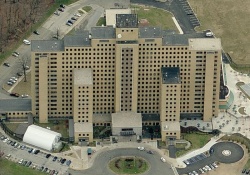Difference between revisions of "Creedmoor State Hospital"
m |
m |
||
| Line 18: | Line 18: | ||
| peak_patient_population = | | peak_patient_population = | ||
| alternate_names =<br> | | alternate_names =<br> | ||
| + | *Brooklyn State Hospital-Creedmoor Division | ||
*Creedmoor Psychiatric Center | *Creedmoor Psychiatric Center | ||
}} | }} | ||
Revision as of 05:37, 4 January 2014
| Creedmoor State Hospital | |
|---|---|
 | |
| Construction Began | 1912 |
| Opened | 1912 |
| Current Status | Active |
| Building Style | Cottage Plan |
| Location | Jamaica, Queens, NY |
| Alternate Names |
|
Contents
History
Creedmoor Psychiatric Center in Queens Village, Queens, New York, provides inpatient, outpatient and residential services for severely mentally ill patients. The history of the hospital and its campus, which occupies more than 300 acres (1.2 km²) and includes more than 50 buildings, reflects both the urbanization of the borough of Queens, New York, and a series of changes in psychiatric care.
Early History of the Site
The hospital’s name derives from the Creeds, a family that previously farmed the site. The local railroad station on a line that ran from Long Island City to Bethpage took the name Creedmoor, apparently from the phrase “Creed’s Moor,” describing the local geography. In the early 1870s, New York State purchased land from the Creeds for use by the National Guard and by the National Rifle Association (NRA) as a firing range. The Creedmoor rifle range hosted prestigious international shooting competitions, which became the forerunner of the Palma Trophy competition. In 1892, as a result of declining public interest and mounting noise complaints from the growing neighborhood, the NRA deeded its land back to the state.
History of the Hospital
Creedmoor State Hospital opened as the farm colony for Brooklyn State Hospital (now Kingsboro), with 32 patients who worked the farmland as part of their treatment, and to ease the expense of their room and board. This was a time when fresh air, physical labor, and rural living were thought to be the best cures for diseases as wide ranging as hysteria and dementia. A self-sustaining community was developed, and to this day many lament the cessation of such programs.
By 1918, Creedmoor’s own census had swollen to 150, housed in the abandoned National Guard barracks. By 1959, the hospital housed 7,000 inpatients. Strange anecdotes regarding Creedmoor and the surrounding areas populated the New York Times’ archives far before deinstitutionalization. The hospital came under scrutiny in the 1940s after a dysentery outbreak due to unsanitary living conditions in the wards. One article tells of a 26-year-old German man with a foot-long beard caught living as a hermit in the woods near Creedmoor in 1931 (police prepared him a steak dinner after arrest). A 1953 article reported two mentally deranged patients overpowering an attendant and escaping Creedmoor, avoiding capture despite a 13-state police alarm. Creedmoor is described as an overcrowded, understaffed, depressing institution in Susan Sheehan's Is There No Place On Earth For Me? (1982), a biography of a patient pseudonymously called Sylvia Frumkin.
By 1974, the hospital was completely out of control, with on-campus crime reaching horrifying numbers: three rapes, 22 assaults, 52 fires, 130 burglaries, six suicides, a shooting, a riot, and an attempted murder occurred within 20 months of each other. And then, in 1984, a patient died after being restrained in a straitjacket and beaten by a staff member with a blackjack.
Staff members reported terrible conditions during this time: being locked in the violent ward, outnumbered by men committed for violent abuse moved to Creedmoor straight from prison, and having to sneak weapons into work for self-defense. A 1977 article tells of one patient who, despite being committed due to stabbing his wife 60 times in the chest and strangling his child with an electric cord, was allowed to freely wander the grounds until the day he casually escaped. Furthermore, this was not an infrequent problem, as Creedmoor maintains an open gate policy despite its solid population of criminals convicted for violent crimes.
The hospital's census had declined by the early sixties, however, as the introduction of new medications, along with other factors, led to the deinstitutionalization of many psychiatric patients around the world. By 2006, parts of the Creedmoor campus had been sold and the inpatient census was down to 470. Today Creedmoor is divided into two sections by Union Turnpike, with the state Office of Mental Health’s psychiatric center in the north. The south campus is home to a number of different programs — some run by various state offices, others by independent nonprofits — many of which provide outpatient services to people with substance-abuse, psychiatric and/or developmental-disability issues.
Programs
The hospital’s notable ventures include The Living Museum, which showcases artistic works by patients and is the first museum of its kind in the U.S. In addition, Creedmoor is home to a self-appointed Chassidic Rebbe known as the Admou"r meCreedmoor. The Admou"r is suspected of taking advantage of his diagnosis of multiple personality syndrome in order to defraud Federal and State entitlement programs.
Between the years of 1961 and 1966 LSD-25 was tested on a group of schizophrenic children in the hospital's Children's Unit.
Images
Main Image Gallery: Creedmoor State Hospital




